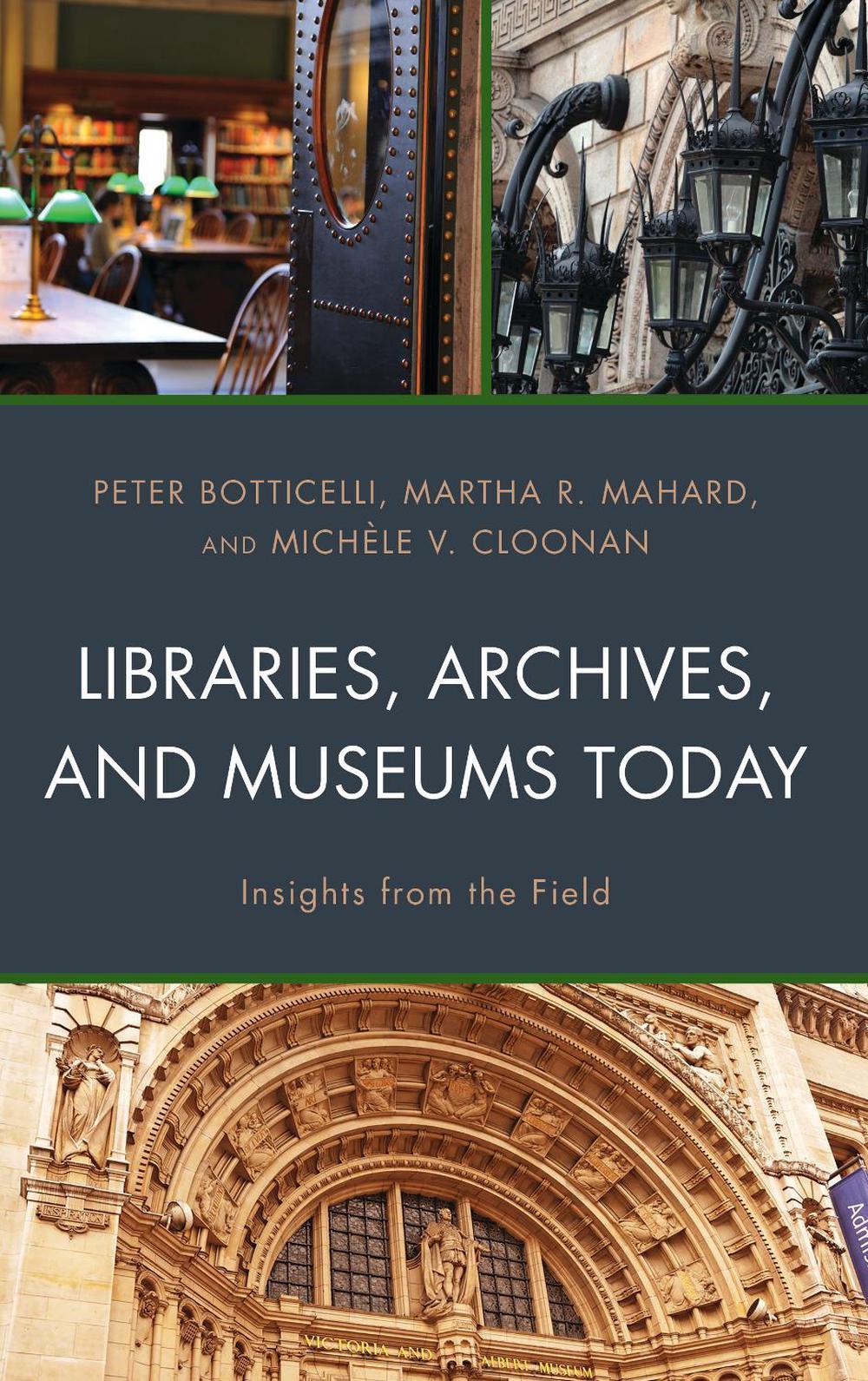
When you click on links to various merchants on this site and make a purchase, this can result in this site earning a commission. Affiliate programs and affiliations include, but are not limited to, the eBay Partner Network.
Libraries, Archives, and Museums Today: Insights from the Field by Peter Bottice

- Item No : 156829830206
- Condition : Brand New
- Brand : No brand Info
- Seller : the_nile
- Current Bid : US $42.05
-
* Item Description
-
The Nile on eBay

Libraries, Archives, and Museums Today
by Peter Botticelli, Martha R. Mahard, Michèle V. Cloonan
This book explores the intersections among libraries, archives, and museums (LAMs) in such practices as digital content creation, conservation and preservation, collections cataloging, digital asset management, digital curation and stewardship, expanding user experiences, and cultivating digital cultural communities.
FORMAT
PaperbackLANGUAGE
EnglishCONDITION
Brand New
Publisher Description
This book offers insights into changes brought about by the enormous growth of the internet. There are new ways to share cultural heritage materials through online finding aids, exhibits, and other initiatives. What has been accomplished across libraries, archives, and museums? The authors consider that question by using case studies to explore activities in 14 libraries, archives, museums, and other heritage organizations. They consider what we can learn from current collaborations within and across libraries, archives, and museums and why some collaborations are successful while others cannot be sustained. Their findings are based on observations and interviews at institutions and organizations in the United States, Australia, and the U.K.These organizations have worked to make their collections accessible. Some have simply digitized their collections, while others have enhanced their collection management systems. Others have incorporated digital asset management systems to organize and retrieve media, and to manage digital rights and permissions. Most of these institutions and organizations have succeeded through strategic partnerships, strategic planning, and insightful leadership. However, the book also contains examples of institutions that have undergone transitions: one of the museums closed, and another closed its library. Taken together, the fourteen institutions shed light on professional practices today.
Author Biography
Peter Botticelli is Assistant Professor at Simmons College School of Library and Information Science where he is program director for the Digital Stewardship Certificate. His current research interests are focused on digital preservation and the curation of digital exhibitions. Botticelli has A.M. and Ph.D. degrees in History from the University of Illinois at Urbana-Champaign, and an M.S.I. degree with a concentration in Archives and Records Management from the University of Michigan School of Information. His most recent position was at the University of Arizona School of Information Resources and Library Science, where he directed the School's Digital Information Management (DigIn) graduate certificate program. Previously, he has held research positions at Cornell University Library, the University of Michigan, and Harvard Business School.Michèle V. Cloonan is Dean Emerita and Professor in the School of Library and Information Science at Simmons College. In 2012 she became editor-in-chief of Preservation, Digital Technology & Culture. She holds degrees from Bennington College, the University of Chicago, and the University of Illinois, from which she earned her Ph.D. She has published widely in preservation and the book trades. Her most recent book is Preserving Our Heritage: Perspectives from Antiquity to the Digital Age (2015). Her honors and awards include the 2010 Paul Banks and Carolyn Harris Preservation Award, from the Association for Library Collections & Technical Services, American Library Association. With Martha Mahard and Peter Botticelli she coordinates the Cultural Heritage Informatics concentration at Simmons.Martha R. Mahard is a Professor of Practice at Simmons College School of Library and Information Science where she teaches courses in management of photographic archives, art documentation, cultural heritage informatics, and digital preservation. She holds a Doctor of Arts in Library Administration from Simmons and degrees from Barnard College and Tufts University. Before joining the Simmons faculty, she worked in the Harvard University Library system for many years. She is the co-author, with Ross Harvey, of the Preservation Management Handbook: A 21st Century Guide for Libraries, Archives, and Museums (2014).
Table of Contents
Foreword, Joyce RayPrefaceAcknowledgmentsIntroductionPart I. Strategies for Small, Independent Institutions with Few ResourcesChapter 1.: The American Antiquarian Society: Digital Asset Management in an Independent Research Library, Peter BotticelliChapter 2. The History Project: Increasing Access to LGBT History in Boston, Samantha Strain and Peter BotticelliChapter 3. Historic New England: Building a Complex Infrastructure, Peter Botticelli, Martha R. Mahard, Michèle V. Cloonan, and Brett FreiburgerChapter 4. The Maine Memory Network: A Statewide Collaboration, Peter Botticelli and Emeline Dehn-ReynoldsPart II. Collaboration within and across InstitutionsChapter 5. The American Archive of Public Broadcasting: Media Access and Preservation, Peter Botticelli, Bryce Roe, and Lily TroiaChapter 6. Cornell University Library Division of Rare and Manuscript Collections: Exploring New Media in the Archive, Peter BotticelliChapter 7. The Museum of Modern Art: A Cross-Institutional Collaboration, Peter BotticelliChapter 8. The Boston Public Library: An Effective Strategy for Advancing Digital Access, Peter BotticelliPart III. Strategic Use of ResourcesChapter 9: The Victoria and Albert Museum: Collaboration for Better Access, Martha R. MahardChapter 10: The National Library of Australia: Digital Assets as a Driver for Change in a National Library, Ross Harvey and Jaye WeatherburnPart IV. Institutions in TransitionChapter 11: The Leviathan Library and Archives at the Jackman Museum of Modern Art: The Impact of Changing Priorities, Michèle V. CloonanChapter 12: The American Textile History Museum, 1960-2018: A Museum That Lives on Through its Collections, Michèle V. CloonanChapter 13: Phillips Library, Peabody Essex Museum: Divergent Visions, Michèle V. Cloonan and Martha R. MahardPart V. Culturally Sensitive MaterialsChapter 14: Harvard Peabody Museum of Archaeology and Ethnology, Peter BotticelliConclusionAppendix: Interview Questions
Review
A light in the darkness, Botticelli, Mahard, and Cloonan's timely collection will help everyone from aspiring students to current information professionals understand the challenges that libraries, archives, and museums have faced over the past few decades, while exploring potential solutions to our shared information problems. With their engaging prose, positive outlook, and rich research data, the authors encourage us to celebrate our commonalities, embrace our differences, and prepare for a new future of communication, collaboration, and innovation across libraries, archives, and museums. -- Paul F. Marty, Professor, School of Information, Florida State University
Using over a dozen case studies, the authors illustrate how the interests of library, archives, and museums have converged over the last three decades, leading to new opportunities for collaboration and innovation. Libraries, Archives and Museums Today offers readers a rich array of stories about adaptation and transformation of cultural heritage institutions in the digital age. -- Karen F. Gracey, Associate Professor, School of Information, Kent State UniversityLong Description
This book offers insights into changes brought about by the enormous growth of the internet. There are new ways to share cultural heritage materials through online finding aids, exhibits, and other initiatives. What has been accomplished across libraries, archives, and museums? The authors consider that question by using case studies to explore activities in 14 libraries, archives, museums, and other heritage organizations. They consider what we can learn from current collaborations within and across libraries, archives, and museums and why some collaborations are successful while others cannot be sustained. Their findings are based on observations and interviews at institutions and organizations in the United States, Australia, and the U.K. These organizations have worked to make their collections accessible. Some have simply digitized their collections, while others have enhanced their collection management systems. Others have incorporated digital asset management systems to organize and retrieve media, and to manage digital rights and permissions. Most of these institutions and organizations have succeeded through strategic partnerships, strategic planning, and insightful leadership. However, the book also contains examples of institutions that have undergone transitions: one of the museums closed, and another closed its library. Taken together, the fourteen institutions shed light on professional practices today.
Review Quote
A light in the darkness, Botticelli, Mahard, and Cloonan's timely collection will help everyone from aspiring students to current information professionals understand the challenges that libraries, archives, and museums have faced over the past few decades, while exploring potential solutions to our shared information problems. With their engaging prose, positive outlook, and rich research data, the authors encourage us to celebrate our commonalities, embrace our differences, and prepare for a new future of communication, collaboration, and innovation across libraries, archives, and museums.
Details
ISBN1538125552Author Michèle V. CloonanPublisher Rowman & LittlefieldYear 2019ISBN-10 1538125552ISBN-13 9781538125557Format PaperbackSubtitle Insights from the FieldPlace of Publication Lanham, MDCountry of Publication United StatesDEWEY 025.1Pages 198Imprint Rowman & LittlefieldShort Title Libraries, Archives, and Museums TodayLanguage EnglishUK Release Date 2019-02-08NZ Release Date 2019-02-08Alternative 9781538125540Audience Professional & VocationalAU Release Date 2019-02-14Publication Date 2019-02-08US Release Date 2019-02-08


-
- The Lost Super Foods
- $ 37.00
- The Self-Sufficient Backyard
- $ 37.00
- A Navy Seals BUG IN GUIDE
- $ 39.00
- Childrens Books Phonics Lot 60
- $ 34.99
















